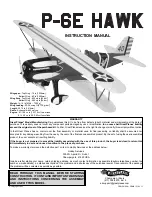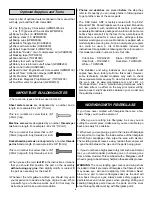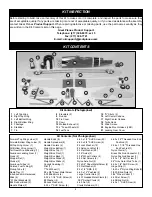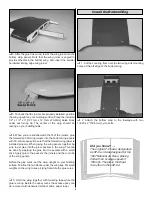
5. You must correctly install all R/C and other components so
that the model operates correctly on the ground and in the air.
6. You must check the operation of the model before every
flight to insure that all equipment is operating and that the
model has remained structurally sound. Be sure to check
clevises or other connectors often and replace them if they
show any signs of wear or fatigue.
7. If you are not already an experienced R/C pilot, you
should fly the model only with the help of a competent,
experienced R/C pilot.
8. While this kit has been flight tested to exceed normal use,
if the plane will be used for extremely high stress flying, such
as racing, the modeler is responsible for taking steps to
reinforce the high stress points.
9. WARNING: The cowl, landing gear covers and wing struts
included in this kit are made of fiberglass, the fibers of which
may cause eye, skin and respiratory tract irritation. Never
blow into a part to remove fiberglass dust, as the dust will
blow back into your eyes. Always wear safety goggles, a
particle mask and rubber gloves when grinding, drilling and
sanding fiberglass parts. Vacuum the parts and the work
area thoroughly after working with fiberglass parts.
Remember: Take your time and follow the instructions to
end up with a well-built model that is straight and true.
If you have not flown this type of model before, we recommend
that you get the assistance of an experienced pilot in your R/C
club for your first flights. If you’re not a member of a club, your
local hobby shop has information about clubs in your area
whose membership includes experienced pilots.
In addition to joining an R/C club, we strongly recommend you
join the AMA (Academy of Model Aeronautics). AMA
membership is required to fly at AMA sanctioned clubs. There
are over 2,500 AMA chartered clubs across the country.
Among other benefits, the AMA provides insurance to its
members who fly at sanctioned sites and events. Additionally,
training programs and instructors are available at AMA club
sites to help you get started the right way. Contact the AMA at
the address or toll-free phone number that follows.
Academy of Model Aeronautics
5151 East Memorial Drive
Muncie, IN 47302-9252
Tele. (800) 435-9262
Fax (765) 741-0057
Or via the Internet at:
http://www.modelaircraft.org
This is the list of hardware and accessories required to finish
the P-6E Hawk. Order numbers are provided in parentheses.
❏
Engine (refer to the engine size requirements on the
cover of the manual)
❏
4-Channel radio
❏
(1) standard servo (throttle)
❏
(4) servos with minimum of 54 oz/in torque
(2-ailerons, 1-elevator, 1-rudder)
❏
(2) 6" [300mm] servo extensions (for aileron servos,
HCAM2701 for Futaba
®
)
❏
(1) Y-harness (for aileron servos, HCAM2751for Futaba)
❏
(1) minimum 1,000mAh receiver battery
❏
Propeller and spare propellers (refer to your engine
manufacturer’s recommendations)
In addition to common household tools and hobby tools, this
is the “short list” of the most important items required to build
the P-6E Hawk ARF.
Great Planes Pro
™
CA and Epoxy glue
are recommended.
❏
R/C foam rubber (1/4" [6mm] – HCAQ1000, or
1/2" [13mm] – HCAQ1050)
❏
1 oz. [30g] Thin Pro CA (GPMR6002)
❏
1 oz. [30g] Medium Pro CA+ (GPMR6008)
❏
Pro 30-minute epoxy (GPMR6047)
❏
Pro 6-minute epoxy (GPMR6045)
❏
Threadlocker
™
thread-locking cement (GPMR6060)
❏
Drill bits: 1/16" [1.6mm], 5/64" [2mm], 3/32" [2.4mm], 1/8"
[3mm], #29 or 9/64" [3.6mm], 3/16" [4.8mm], 7/32" [5.5mm]
❏
8-32 tap
❏
1/2" wrench
❏
Hex head wrench set
❏
5 pkgs Stick-on segmented lead weights (GPMQ4485)
❏
#1 Hobby knife (HCAR0105)
❏
#11 Blades (5-pack, HCAR0211)
❏
Small T-pins (100, HCAR5100)
❏
R/C-56 canopy glue (JOZR5007)
❏
CA applicator tips (HCAR3780)
❏
Denatured alcohol (for epoxy cleanup)
❏
Curved-tip canopy scissors for trimming plastic parts
(HCAR0667)
Adhesives and Building Supplies
Hardware and Accessories
ADDITIONAL ITEMS REQUIRED
Note: We, as the kit manufacturer, provide you with a top
quality kit and great instructions, but ultimately the quality
of your finished model depends on how you build it;
therefore, we cannot in any way guarantee the
performance of your completed model, and no
representations are expressed or implied as to the
performance or safety of your completed model.
3




































